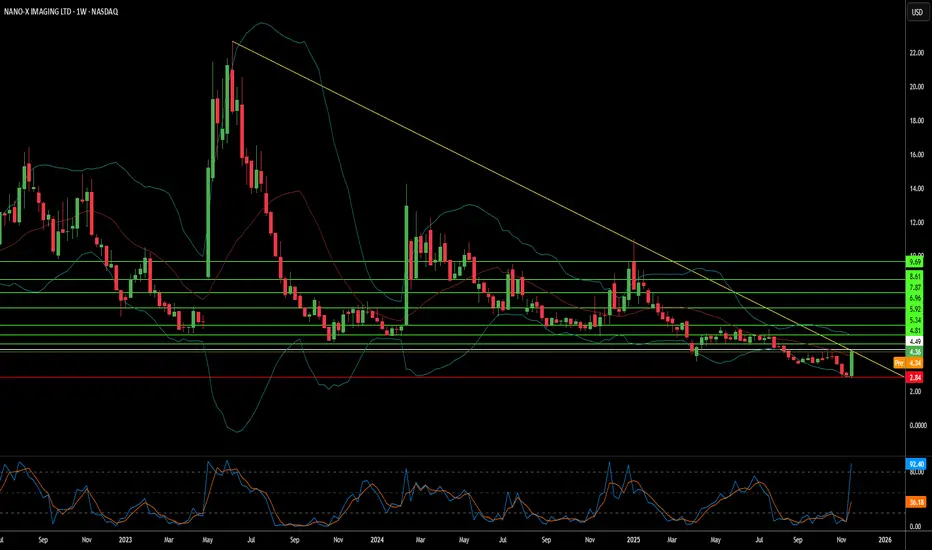Nano-X Imaging is attempting to fundamentally restructure the medical imaging industry through a convergence of semiconductor innovation and business model disruption. The company has commercialized a cold cathode X-ray source that replaces the century-old thermionic emission technology, which wastes 99% of energy as heat, with field emission from millions of molybdenum nano-cones operating at room temperature. This breakthrough, manufactured in their South Korean semiconductor fabrication facility near the SK Hynix cluster, enables the Nanox.ARC system: a compact, digitally-agile tomosynthesis device that eliminates the need for massive cooling systems and rotating gantries that have defined traditional CT scanners.
The commercial strategy centers on "Medical Screening as a Service" (MSaaS), converting imaging from a capital expenditure to an operational expense, which is particularly advantageous in the current high-interest-rate environment, where hospitals face capital budget constraints. Strategic partnerships provide immediate market access: the 3DR Labs agreement connects Nanox to over 1,800 US hospitals, integrating FDA-cleared AI algorithms (HealthCCSng, HealthOST, HealthFLD) directly into existing radiology workflows, while international deployments span Mexico (630 units with SPI Medical), South Korea and Vietnam (2,500 systems supported by SK Telecom), and European reference sites in France. Management has issued ambitious guidance of $35 million in revenue for 2026, representing approximately 900% growth from 2025 levels, progressing toward a projected $72.6 million by 2028.
The investment thesis rests on technological validation (FDA 510(k) clearance, operational semiconductor fab), geopolitical resilience (supply chain decoupled from Middle East instability), and macroeconomic alignment (OpEx-based model favored during capital constraints). However, execution risks remain significant: the company maintains a substantial cash burn rate ($30.4 million in negative operating cash flow), requires continued capital raises (most recently, a $15 million offering), and faces adoption uncertainty as hospitals evaluate this novel service model. Analyst sentiment is bullish with price targets averaging $7.75 (120%+ upside), though more aggressive projections reach $23, contingent on the successful scaled deployment of the recurring revenue model that fundamentally challenges the traditional equipment sales paradigm of incumbent manufacturers like GE, Siemens, and Philips.
The commercial strategy centers on "Medical Screening as a Service" (MSaaS), converting imaging from a capital expenditure to an operational expense, which is particularly advantageous in the current high-interest-rate environment, where hospitals face capital budget constraints. Strategic partnerships provide immediate market access: the 3DR Labs agreement connects Nanox to over 1,800 US hospitals, integrating FDA-cleared AI algorithms (HealthCCSng, HealthOST, HealthFLD) directly into existing radiology workflows, while international deployments span Mexico (630 units with SPI Medical), South Korea and Vietnam (2,500 systems supported by SK Telecom), and European reference sites in France. Management has issued ambitious guidance of $35 million in revenue for 2026, representing approximately 900% growth from 2025 levels, progressing toward a projected $72.6 million by 2028.
The investment thesis rests on technological validation (FDA 510(k) clearance, operational semiconductor fab), geopolitical resilience (supply chain decoupled from Middle East instability), and macroeconomic alignment (OpEx-based model favored during capital constraints). However, execution risks remain significant: the company maintains a substantial cash burn rate ($30.4 million in negative operating cash flow), requires continued capital raises (most recently, a $15 million offering), and faces adoption uncertainty as hospitals evaluate this novel service model. Analyst sentiment is bullish with price targets averaging $7.75 (120%+ upside), though more aggressive projections reach $23, contingent on the successful scaled deployment of the recurring revenue model that fundamentally challenges the traditional equipment sales paradigm of incumbent manufacturers like GE, Siemens, and Philips.
Declinazione di responsabilità
Le informazioni e le pubblicazioni non sono intese come, e non costituiscono, consulenza o raccomandazioni finanziarie, di investimento, di trading o di altro tipo fornite o approvate da TradingView. Per ulteriori informazioni, consultare i Termini di utilizzo.
Declinazione di responsabilità
Le informazioni e le pubblicazioni non sono intese come, e non costituiscono, consulenza o raccomandazioni finanziarie, di investimento, di trading o di altro tipo fornite o approvate da TradingView. Per ulteriori informazioni, consultare i Termini di utilizzo.
